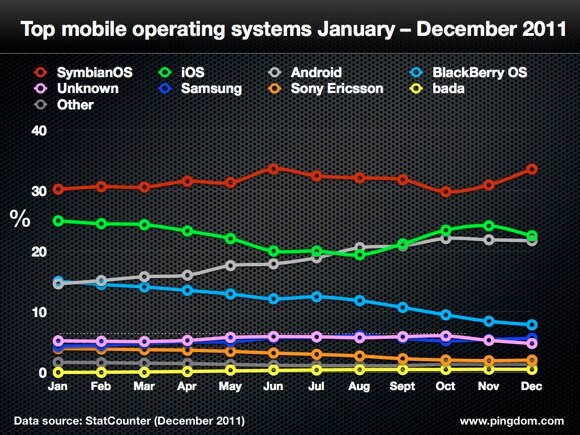
As we’re quickly approaching the end of 2011 we take a last look at what the year for mobile operating systems was like.
Would it surprise you to know that Symbian finished 2011 stronger than it started the year? The much-maligned operating system is still number one, ahead of Android, iOS, and the others.
Here’s how 2011 panned out in mobile operating systems.
Symbian finished 2011 over 11 percentage points ahead of iOS
Using StatCounter’s figures for mobile operating systems we charted the main mobile operating systems during 2011. To summarize, Symbian finished stronger than it started, iOS dropped a little bit, Android gained a lot, and BlackBerry was all but decimated.

A few notes about how the mobile OS market developed over 2011:
- Symbian started and finished 2011 as the undisputed king of mobile OSs. Going from 30.25% in January to 33.59% in December, Symbian made a resurgence in the last two months of the year.
- Apple may take in the bulk of the profits in the mobile industry but in terms of share of mobile operating systems it had a pretty flat 2011. Starting out with 25.02% it falls in the first six months and made a slight recovery to 22.56% in December.
- The Google juggernaut that is Android made a considerable market share improvement from 14.61% to 21.74%. If this development keeps up it won’t be long until Android takes the number two spot from iOS, a position it held for a short time in August 2011.
- The real loser in 2011 is RIM’s BlackBerry OS, which fell from 15.03% to 7.86%. Actually BlackBerry started the year just ahead of Android but fell steadily behind over the twelve months.
- Samsung is obviously a major player in the Android space, but it showed up with both Samsung OS as well as bada, which finished 2011 with 5.62% and 0.5% respectively.
Despite great 2011, Symbian’s future is uncertain
As interesting as it is to see that Symbian has actually increased its share of mobile web browsing a bit in 2011, doubt remains as to the future of the platform. Despite selling almost 24 million Symbian smartphones in Q2 2011, and close to 100 million mobile devices altogether in the same period, not many numbers for Nokia point in a positive direction.
It remains to be seen what developments will happen in 2012 but it seems certain that the competition will only increase. Apple and Google will keep fighting amongst each other but new entries like Mozilla’s Boot to Gecko and Canonical’s Ubuntu for mobile devices may also move in to claim a stake in the market.
Photo credit: “symbian fanboy” by rhinman.



























